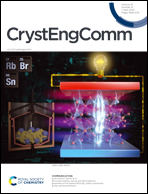The stacking fault annihilation in a-plane AlN during high-temperature annealing†
Abstract
Clarifying the defect evolution mechanism is the key to realizing high-quality non-polar AlN based materials and devices. In this work, the basal stacking fault density of the sputtered nonpolar a-plane wurtzite AlN (a-AlN) template decreased from 27 100 cm−1 to 5500 cm−1 by high-temperature annealing and the underlying mechanism is systematically investigated by first-principle calculations. By analysing the minimum energy pathway during the elimination of the I1-type stacking fault, it was found that two I1-type stacking faults transform into one I3-type stacking fault as the intermediate state and then annihilate. The highest energy barriers for eliminating and forming the I1-type stacking default are 5.032 eV and 5.204 eV, respectively, explaining the phenomenon that the BSFD decreases at first and then increases with the increasing annealing temperature. In addition, the FWHMs of (11−20) XRC along different azimuth angles are nearly uniform instead of the normal ‘M’ shape, indicating that the crystal quality of a-AlN improved uniformly along different azimuth angles after high-temperature annealing. The results presented here are a significant step towards the synthesis of high-quality non-polar AlN material and non-polar light-emitting diodes.



 Please wait while we load your content...
Please wait while we load your content...